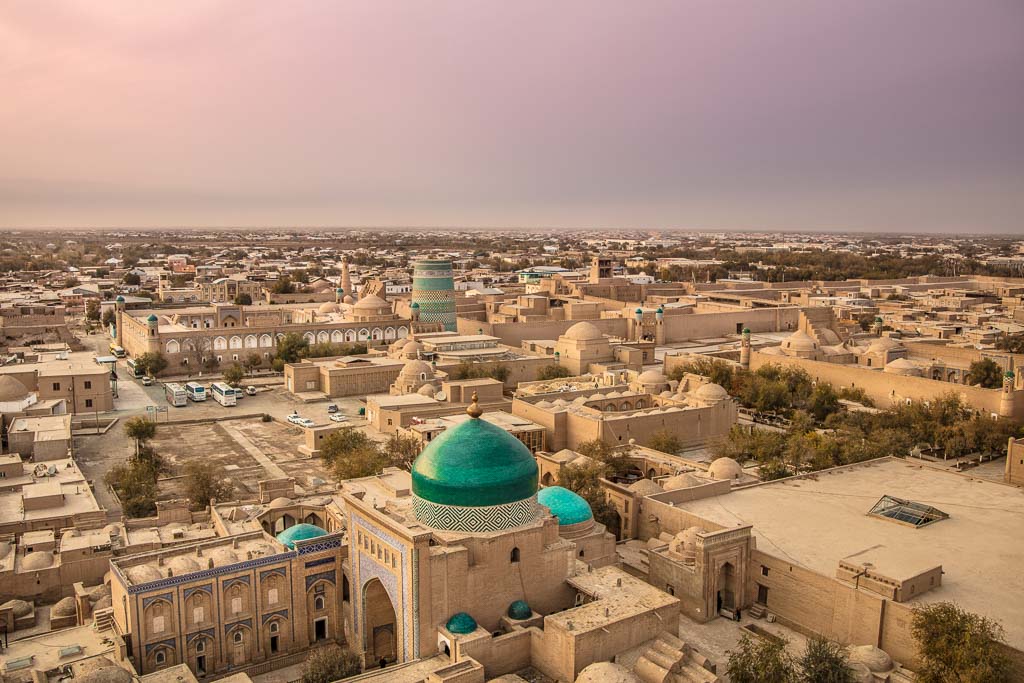Khiva is the ancient capital of the Corasmia region of Uzbekistan along the Silk Road. It was the first site in the Uzbek state to be inscribed on the World Heritage List in 1991 thanks to the historic center of Itchan Kala. According to a myth, it was Noah’s son Shem who founded the city.
It was a center for the slave trade, a city of brigands where one arrived after exhausting journeys in the desert. Today, it is a museum town where about three thousand people live, reviving the charm of the old traditions. It has the appearance of a rectangular fortress, surrounded by imposing walls: nowhere else than in Itchan Kala, the city within the walls, one can find the atmosphere of the desert, between the mud walls and the shades of ochre that dominate the old city.
Located south of the Amu Darya river, it was once an oasis for caravans before crossing the desert to Persia. Ancient traditions are still alive among the local population, such as the production of bread. In Khiva, families use clay ovens and in one of the main squares of Itchan Kala, they prepare bread. The influences of Zoroastrianism are very evident on the buildings of Khiva: the urban centers at the time of the Silk Road were centers of exchange of cultures, philosophies and religions.
This city is definitely worth visiting and today we are going to list a few places there that you should not miss. If you haven’t check the first part of this article, you can check it here.
Craft Workshops
In the small spaces of the different madrassas of the old city of Khiva, are hidden handicraft workshops, sometimes carving wood, sometimes weaving silk carpets.
Some of these workshops and the level of detail in each object is incredible. The silk workshop, for example, was created in partnership with UNESCO to preserve traditional techniques. Khiva, as a city on the ancient silk route, is one of the places where you can see how women work to create detailed carpets, scarves, or scarves. The carpentry workshops are equally impressive. In this case, the work is done by men, mostly young men.
Mausoleum of Pakhlavan Mahmud
The mausoleum of Pakhlavan Mahmud was built around 1700. Inside is the tomb of Pakhlavan Mahmud, a poet and fighter who is said to have saved many people from slavery.
The mausoleum is a popular place of pilgrimage where people pray and drink holy water. You can see a huge dome and other features added to the complex more recently – including actual dynastic crypts – dedicated to this Uzbek hero.
Madrasa of Allakuli Khan
The Madrasa of Allakuli Khan was the largest madrasa in Khiva, housing a large library. Previously, this library provided books to the entire student population of the city. Experts point out that the architecture is in the Khorezm style, dating from the late Middle Ages.
Built in 1834 with its own funds, it is located between the covered bazaar (Tim Allakuli Khan) and the eastern gate (Palvan Darvoza) and faces another incredible madrassa – Khodjamberdy Bey or Madrassa Allakuli Khan.
The outdoor patio is beautiful and a good place to relax at the end of the day. If you cross the street, you will find an excellent restaurant for dinner.
Tosh-Hovli Palace
Tosh-Hovli Palace (also called Stone Palace or Tash Khauli) was the summer residence of the kings in Khiva and is a must visit on a trip to Khiva. The Tash-Khovli Palace was built in the 19th century and has three large courtyards connected by several corridors and passages.
In one of them, a carriage is exposed and in another, in the outer courtyard, there is a yurt. It has rooms with tiled ceilings, a small museum with various tools and another room where musical instruments are displayed.
You now know what to visit in Khiva and we hope you will enjoy your trip there. Until then, what’s your most favorite country that you’ve visited? Share your experience with us below.

Leave a Reply
You must be logged in to post a comment.